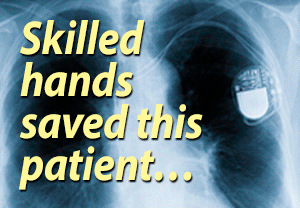 Resting rate
Resting rate
- by Jimmy S
- 2022-04-09 09:00:35
- General Posting
- 759 views
- 5 comments
I am a 68-year-old male who has a fib. Four years ago I had three ablations they did not work. I still had a fib so they put me on a strong heart medicine Tykosyn which seem to work for a couple of years I was in normal sinus rhythm. However about a year ago I got Covid stuff despite being vaccinated twice for whatever reason the doctors think that the Covid blew out my AV node system and I had no electrical going to my lower chamber and I was having complete heart failure. They rushed me to the hospital because my I watch showed 30 bpm and dropping. They quickly inserted a 2 lead pacemaker. I went immeadily to 70 Bpm. I was 100% pacemaker dependent. however after three weeks my doctor said that the pacemaker device should've been at three Lead device and they put in a three-way device with the third lead going to lower chamber.
Since then I am feeling very good but I am still in a fib. My only question is my resting rate is 80 and I think it should be probably 70. I go to sleep at night the lowest it goes is 80. What would be the benefits or disadvantages of them settting it to 70. I'm 6 foot tall 220 pounds in fairly good shape former college footballer but don't exercise as much as I used to because of the a fib.
I am new to the forum and very excited to be a member.
5 Comments
Questions
by Jimmy S - 2022-04-10 00:35:05
Hey Agent,
thanks for getting back to me! I'm not really up on acronyms so it's a few things I'm not sure of. what does DDDDX mean?What does VVV I R mean?
Thanks For explaining SCA because I think I was almost there because as my heart was dropping down from 30 to 25. The second they gave my an external pacemaker it went back up to 70. It was an emergency room procedure and for whatever reason my EP doctor felt that I needed a three lead pacemaker. I feel great when I'm resting but I can't go more than 100 yards with being out of breath. Meeting with one of the top EP ablation specialist in the country in May. Hopefully he can get me out of a fib and the pacemaker continues to do his job. My concern about seeing 80 is my resting with that cause my pacemaker to use more average battery life? Also is there any chance that the pacemaker can alleviate the a fib symptoms when I exercise.
Thanks for the advice and I really like the comment about "misfit toys"" it's very funny!
DDD And VVI
by AgentX86 - 2022-04-10 01:48:41
The pacing code describes the use of each lead. The letters used for the first three letters are 'A','V', or 'D", standing for (right) atrium, (right) ventricular leads, with 'D' being both/dual.
The first character tells which lead is being used for pacing.
The second tells us what lead senses for a (natural) pulse.
The third character tells us what happens when a pulse is sensed in the lead, described by the second character). The four possibilities are 'I' (Inhibit, or don't pace), 'T' (trigger a pulse), 'O' (ignore it), or 'D' (dual, it can either inhibit or trigger).
There is a fourth character, which tells us whether the pacemaker is programmed for rate response ('R' = rate response, blank = no rate response). Rate response sets the heart rate for various oxygen demands, or tries to. A heart with a normal SI node wouldn't have rate response set on. If the heart's natural pacemaker doesn't work, rate response is turned on.
Not all combinations make sense, some are rarely used, and some would be dangerous so there are a limited number of possibilities. The most common would be:
So AAI would be an atrial pace, with an atrial sense. If it senses an arial pulse, it inhibits the next pulse. The heart has already supplied it naturally so we don't want another. Since there is no fourth character it's assumed that the sinus nore is responsive to oxygen demand but perhaps it just misses a beat now and then. AAIR would mean that it can't vary the heart rate normally so the pacemaker is responsible for this.
A very common setting would be DDD, which means that either the heart can be paced in the atrium or ventricles, depending on need. If the SI node forgets to pace, the PM will take over. If the signal doesn't make its way to the ventricle, it'll do that too. It'll also either inhibit, trigger, or do nothing based on need. It may switch modes within these combinations if it senses the need (Afib or Aflutter). Rate response may be used, or not.
The next common one is VVI. Here, only the ventricles are paced and only the ventricles are sensed. The atria are out of the picture. VVI could be used for an intermittent AV node (first or second degree block) but has some drawbacks here. It's commonly used for a heart block with perisitent or permanent AF/AFL. In this case, the atria aren't of any use anyway, so they're cut out of the picture. The ventricles are paced independently.
So, if you have paroxymal Afib, you'd probably have your pacemaker set up for DDD. It can then pace normally but when it detects Afib it switches mode to isolate the Afib. It'll then switch back when the Afib corrects itself. If it never corrects (persistent or permanent), VVIR makes more sense because there is no reason to switch between modes. It's always one way.
The above isn't the whole story but it should give you some idea. You can search on "pacemaker code" or "pacemaker modes" for more information.
Thank you Agent!
by Jimmy S - 2022-04-10 11:44:02
Appreciate the detailed email on the acronyms now they make a lot more sense. Just concerned about this next Ablation being the first three I did not have a pacemaker. So I'm just curious how people with pacemakers do with ablationd when they trying to get back in the sinus rhythm. I wil keep all posted..
jimmy S
Heart rate questions
by Gotrhythm - 2022-04-13 14:12:24
There isn't any magical right number for heart rate. The only question is "how do you feel?"
If you feel good with the hr at 80, and you can get to sleep okay, there's really no need to change it. Changes in hr don't substanially affect battery depletion.
You know you're wired when...
Your pacemaker receives radio frequencies.
Member Quotes
I'm 35 and got my pacemaker a little over a year ago. It definitely is not a burden to me. In fact, I have more energy (which my husband enjoys), can do more things with my kids and have weight because of having the energy.

.png)



Resting Rate
by AgentX86 - 2022-04-09 12:12:31
Welcome to the club of misfit toys. It would be good if you could fill in more of your situation in your bio so we could reference it.
There isn't a lot of information to go by here. Since you still have Afib it would seem that your PM is in DDDx, or some such. It's also not clear why you needed the third lead so soon, assuming DDDx. If this is the case, your PM could be set to 80bpm to try to out-pace your AF. Sometimes it works.
You could have been shifted to VVIR mode at the time of the PM switch so your AF wouldn't propagate. Technically, you would still be in AF but you couldn't feel it. If this is the case, there is a risk of SCA (Sudden Cardiac Arrest). A HR of 80bpm seems to reduce the probablility of SCA to virtually zero. Usually, they'll scale the resting rate back from 80bpm back to its final number (usually 60bpm) over the next few months. You may have been left here for some reason (forgot?). I guess they could still want to lower the instances of AF.
I had an AV ablation, which is essentially an intentional third degree block. A two-lead (RV and LV, no RA lead) is implanted. Since there is no RA lead and no atrial contribution, the mode is set to VVIR. My atria are left to flutter but I'm finally rid of the sensation of the flutter (thank &diety.). My HR was originally set to 80bpm. When my EP started lowering my rate I started getting bigeminal PVC, which were awful. He raised it back to 80bpm to out-pace them and I've been stuck there since. I was dropped to 50bpm at night so I could sleep.
Your PM mode might tell us more. Your EP might be able able to explain even more. ;-)